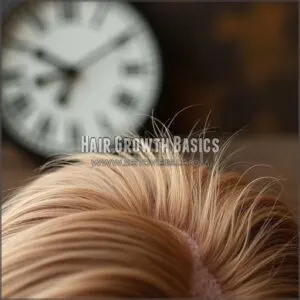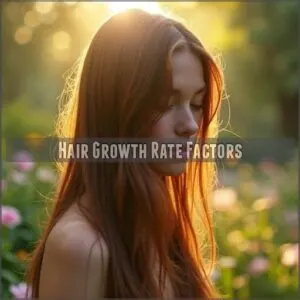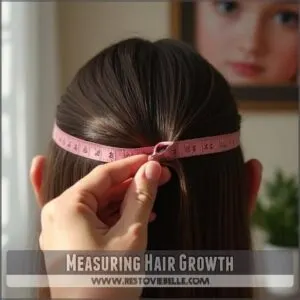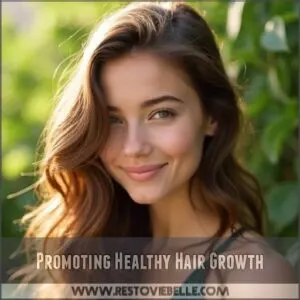This site is supported by our readers. We may earn a commission, at no cost to you, if you purchase through links.
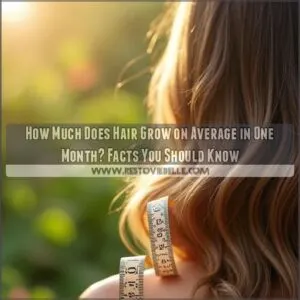 Your hair grows about half an inch each month – just enough to notice when your perfect haircut starts getting a bit shaggy.
Your hair grows about half an inch each month – just enough to notice when your perfect haircut starts getting a bit shaggy.
This growth rate isn’t set in stone, though. Like a garden that thrives with proper care, your hair’s growth depends on various factors including your genetics, diet, and overall health.
While you can’t control everything (thanks, DNA!), you’d be surprised how much influence you have over your hair’s growth rate. Proper nutrition, stress management, and gentle hair care practices can help your locks reach their full potential.
Understanding these growth factors is key to maintaining your healthiest hair possible.
Table Of Contents
- Key Takeaways
- Hair Growth Basics
- Average Monthly Hair Growth
- Hair Growth Rate Factors
- Calculating Hair Growth
- Promoting Healthy Hair Growth
- Common Hair Growth Myths
- Maintaining Optimal Hair Health
- Frequently Asked Questions (FAQs)
- How much hair grows in a month?
- How fast does hair grow?
- How long does hair growth last?
- How long does hair grow on your head a year?
- How do I calculate 6 month hair growth?
- How long does hair grow if not cut?
- What is the difference between curly hair and straight hair?
- How much hair are we born with?
- Why do we get gray hair?
- Why do we have hair in the first place?
- Conclusion
Key Takeaways
- Your hair grows about half an inch (1.25 centimeters) per month, though this can vary based on your genetics, diet, and overall health
- You’ll go through three distinct hair growth phases: anagen (growth), catagen (transition), and telogen (rest), with each follicle operating independently
- You can support your hair’s growth rate through proper nutrition, stress management, and gentle hair care practices, while avoiding harsh styling techniques that can damage follicles
- Your hair will continue growing for 2-6 years during its active phase, potentially reaching 18-30 inches before naturally shedding and restarting the growth cycle
Hair Growth Basics
Hair grows in cycles, moving through growth, resting, and shedding phases that repeat naturally over time.
On average, your hair gains about half an inch per month, though this can vary based on factors like age, genetics, and health.
Hair Growth Cycle
The hair growth cycle runs through three phases: anagen (growth), catagen (transition), and telogen (rest).
Each hair follicle operates independently, creating varied cycle lengths.
While active, follicles produce new hair, pushing out old strands during hair shedding.
On average, monthly hair growth reaches about 0.5 inches, but the hair growth rate depends on follicle health and individual factors.
Hair Structure and Function
Your hair’s growth starts deep within hair follicles, where protein cells multiply to form strands.
Each strand passes through the scalp, protected by a cuticle layer, which influences hair texture.
Strong scalp health boosts the hair growth rate, while average monthly growth remains about half an inch.
Understanding the hair growth cycle is essential for maintaining healthy hair.
Though technically dead, hair reflects internal health in its speed and appearance.
Factors Affecting Hair Growth
Genetic influence and hormonal balance play huge roles in your hair growth rate, while nutrient intake keeps strands strong and healthy.
Stress levels can mess with the cycle, slowing hair growth speed. Even water quality affects it—hard water can dry out your scalp.
Want consistent average hair growth per month? Focus on these hair growth factors for healthier locks!
Average Monthly Hair Growth
In a month, hair grows an average of about 0.5 inches, though some might notice slight variations.
This depends on factors like age, health, and follicle health.
The hair growth rate in inches stays fairly consistent, averaging 6 inches a year, but hair thickness and texture can change how quickly it seems to grow.
Daily shedding (up to 100 hairs) is normal; it’s part of the growth cycle.
Maintaining healthy habits helps support both hair thickness and your average monthly growth.
Hair Growth Rate Factors
Your hair’s growth rate isn’t the same as everyone else’s because it depends on factors like genetics, hormones, and diet.
Things like stress, illness, and even your environment can also make a big difference in how fast your hair grows.
Genetics and Hormones Role
While average hair growth is about half an inch monthly, your DNA factors play a starring role.
Hair inheritance from your family determines your hair growth cycle and follicle health. Hormones also hold sway, with imbalances sometimes throwing a wrench in the works.
Understanding hair loss genetics can provide valuable insights into the role of genetics in hair growth. Genetic testing can offer insights into your DNA’s influence on your average hair growth and hair growth rate, helping you understand your unique hair journey.
Nutrition and Diet Impact
Beyond genetics and hormones, your diet plays a starring role in hair growth rate. Adequate vitamin intake, mineral balance, and meeting your caloric needs are essential.
Macronutrients, like protein, fuel healthy hair growth. Eating hair growth foods can substantially impact the health and strength of your hair.
Hydration also plays a part; think of water as a fertilizer for your hair. So, remember, nutrition and hair growth go hand-in-hand, impacting both average hair growth and your hair growth in months.
Environmental Factors Influence
Pollution, a significant environmental factor, can affect your hair growth monthly rate.
Air pollution can irritate your scalp, impacting hair growth in months.
Hard water, due to its mineral content, can make hair brittle, affecting the hair growth per month average.
Similarly, sun exposure can damage hair, influencing the hair growth rate in millimeters.
Consider water quality and climate change as other environmental factors impacting hair growth.
Protecting your hair from these elements is essential for maintaining healthy hair growth.
Stress and Illness Effects
Stress and illness aren’t just bad for your mood—they can fast-track your hair into the telogen phase, causing noticeable shedding.
Stress impact, like telogen effluvium, shifts the hair cycle, slowing growth.
Illness effects, such as hormonal changes or major surgeries, bring similar struggles.
- Expect temporary hair loss after stress or illness.
- Manage stress to maintain your hair growth rate.
- Watch hormone levels for unexpected changes.
Calculating Hair Growth
You can easily figure out how long your hair will grow in a specific timeframe, or how many months it’ll take to reach a certain length.
This simple calculation uses the average growth rate to give you a good estimate of your hair’s progress.
Hair Growth Calculator
Want to predict your hair length? Use a hair growth calculator! On average, hair grows half an inch per month (hair growth per month average).
A hair growth calculator uses your current hair length and desired length to estimate the time needed, factoring in average hair growth rate.
This helps track hair length growth, though individual growth speed and hair density vary.
Remember, scalp health and follicle care are key for ideal growth.
Measuring Hair Growth
Curious about your hair growth rate? A ruler or tape measure can track hair length changes.
Start by measuring from your scalp to the hair tip. Regular measurements reveal your monthly hair regrowth and overall hair growth speed.
Consider factors like hair thickness and growth patterns for a thorough scalp analysis, offering insights into your average hair growth rate and hair growth per month average.
Tracking Hair Growth Progress
Maintaining a hair diary is a simple method for progress monitoring.
Document your hair length regularly to identify your unique growth patterns.
This tracking method reveals your monthly hair regrowth and helps determine your average hair growth rate, or monthly hair growth average, compared to the average hair growth rate.
To accurately track progress, understanding the hair length chart is essential for measuring and recording hair length effectively.
This empowers you to adjust your hair care routine based on your personal hair growth monthly rate.
Promoting Healthy Hair Growth
You can encourage healthy hair growth by focusing on nutrition, stress management, and gentle hair care. These simple steps can help maximize your hair’s potential, keeping it strong and vibrant.
Balanced Diet and Nutrition
Your hair growth rate thrives on what’s on your plate. A balanced diet packed with healthy fats and essential nutrients directly impacts your hair’s monthly regrowth.
Focus on foods that boost nutrient absorption and maintain mineral balance: Incorporating a healthy hair diet can greatly enhance the overall health of your hair.
- Omega-3-rich salmon and flaxseeds for stronger follicles
- Iron-packed spinach and lean meats to support the hair growth cycle
- Vitamin-rich nuts and seeds for ideal nutrition
- Greek yogurt and eggs for protein-powered hair growth
Exercise and Stress Management
Regular exercise routines boost hair regrowth rate by reducing stress hormones that can disrupt the hair growth cycle.
A consistent mix of mindful movement and relaxation techniques, like yoga benefits both body and scalp health.
Scientists found that high stress levels directly impact hair loss, but simple stress reduction activities can help maintain your natural hair growth in a month.
Try 30 minutes of daily movement paired with breathing exercises.
Gentle Styling Practices
Treating hair like delicate silk is essential for maintaining its monthly growth rate.
While your hair growth cycle runs its course, practice soft combing from ends to roots, and avoid tight hair tying that can stress follicles.
Using a gentle hair brush can help minimize breakage and tangles.
Low manipulation techniques protect strands during their hair growth in a month phase.
When detangling, use gentle trimming to remove split ends without compromising the hair monthly increase of 0.5 inches, which is a result of hair growth cycle and delicate silk treatment to achieve monthly growth rate.
Scalp Massage Benefits
Now that you’ve mastered gentle styling, let’s talk about scalp massage – your hair’s secret weapon for growth.
A 5-minute daily massage boosts blood circulation to your hair follicles, promoting faster growth.
Using your fingertips in circular motions, you’ll feel stress relief and scalp relaxation kick in.
Want bonus points? Try massage techniques with warm oil – it’s like a spa day for your scalp.
Common Hair Growth Myths
You’ve probably heard countless tips about growing your hair faster, from taking expensive supplements to cutting it more frequently.
Let’s separate fact from fiction and explore what really works for hair growth, so you won’t waste time and money on treatments that don’t deliver results.
Shampoo and Supplements Effectiveness
While pursuing healthy hair growth, you might wonder about shampoos and supplements. The truth is, these products won’t make your hair grow faster, but they can help restore normal growth rates and address nutrient deficiencies.
- Look for shampoos with biotin, collagen, and argan oil
- Avoid products containing sulfates and synthetic fragrances
- Consider supplements if you’re low on vitamins A, B, C, D, or E
- Consult your doctor before starting any supplement routine
Hair Texture and Growth Rate
Many people believe different texture types grow at different speeds, but research shows your hair’s natural texture doesn’t affect its growth rate.
Your growth patterns and hair density stay consistent regardless of whether your hair is straight, wavy, or curly.
What you might notice is that follicle health and scalp conditions play a bigger role in how your hair grows and appears.
Haircuts and Hair Growth Relationship
Unlike hair texture, getting regular haircuts won’t speed up your hair growth monthly rate. Your hair growth cycle and follicle health determine growth – not the scissors! But trimming does help maintain length by preventing split ends and hair breakage.
Understanding the hair growth process is essential to debunking common myths about haircuts and growth.
- Trimming every 6-8 weeks helps prevent damage from traveling up the hair shaft
- Regular haircut frequency maintains shape while hair grows about 0.5 inches monthly
- Split ends can make hair appear shorter despite consistent hair growth in centimeters
- Trimming doesn’t affect the hair growth rate happening at your scalp
- Professional trims help you track hair growth in inches by maintaining a consistent baseline
Maintaining Optimal Hair Health
You’ll need more than just regular shampooing to keep your hair growing at its maximum rate of half an inch per month.
Your hair’s health depends on how you protect it from damage, so you’ll want to develop good habits that include gentle styling and proper scalp care.
Avoiding Harsh Styling Practices
Now that we’ve busted those myths, let’s protect your hair growth rate.
Constant heat styling risks can slash your monthly hair growth from the typical half-inch to barely visible progress.
Your hair growth cycle takes a hit when you’re battling chemical damage and hair breakage.
Skip the daily straightening, limit bleaching, and give those tight ponytails a break.
Focus on frizz control using heat-free methods – your split ends will thank you.
Minimizing Product Buildup
Too much product buildup can seriously slow your hair growth rate in millimeters per month. Regular clarification keeps your scalp healthy and maintains a healthy hair growth monthly rate.
Understanding protein buildup signs is essential for effective prevention. Here’s how to tackle buildup prevention:
- Mix apple cider vinegar with water for gentle cleansing that removes residue without stripping
- Use a scalp exfoliation brush once weekly to lift dead skin and product buildup
- Try a clarifying shampoo monthly for deep hair clarification, focusing on the roots, to prevent product buildup
Protecting Scalp From Damage
Your scalp is like a garden – it needs proper care for healthy hair growth rates.
Protect your hair follicles with scalp sunscreen to prevent UV damage that can slow your monthly hair growth in millimeters.
Using daily scalp protection is essential for maintaining a healthy scalp environment.
Practice gentle shampooing techniques and regular scalp exfoliation.
For ideal scalp health and damage prevention, use heat protection products before styling, and opt for looser hairstyles.
Identifying Hair Loss Signs
Four key signs can warn you about potential hair loss.
Watch for excessive hair shedding during washing or brushing, noticeable scalp issues like redness or itching, and the appearance of bald patches.
Women might notice a widening part or thinner ponytail, while men often experience a receding hairline.
If you’re losing more than 50-100 hairs daily or see inflammation, consult a doctor.
Frequently Asked Questions (FAQs)
How much hair grows in a month?
Hair grows an average of half an inch (or about 25 centimeters) each month.
You’ll notice steady growth at this rate regardless of where you live, though factors like genetics and health can influence it.
How fast does hair grow?
Your locks will typically grow at a steady pace of about half an inch each month, which adds up to 4-6 inches yearly.
Growth speed can vary based on your genetics and overall health.
How long does hair growth last?
Like a well-conducted orchestra, the anagen growth phase can last 2-6 years for your scalp hair. You’ll then experience a brief 2-week intermediate phase, followed by a 100-day resting period.
How long does hair grow on your head a year?
Hair typically grows 4-6 inches per year on your head, depending on factors like genetics, health, and age.
Don’t be surprised if you’re noticing different growth rates – it’s perfectly normal.
How do I calculate 6 month hair growth?
In a flash, you’ll know your growth potential! To calculate 6-month hair growth, multiply 5 inches (average monthly growth) by 6 months. You’ll get approximately 3 inches of total growth.
How long does hair grow if not cut?
Your hair will continue growing for 2-6 years during its active phase, reaching a maximum length of 18-30 inches. After that, it’ll naturally shed and restart the growth cycle.
What is the difference between curly hair and straight hair?
The shape of hair follicles determines if you’ll have straight or curly hair.
Straight hair grows from circular follicles with flat scales, while curly hair emerges from oval-shaped follicles with more volume.
How much hair are we born with?
At birth, you’re equipped with roughly 5 million hair follicles across your body, with about 100,000 of them concentrated on your scalp. These numbers are set for life.
Why do we get gray hair?
Studies show only 6-23% of people globally have 50% gray hair by age
Your hair turns gray when melanin production in your follicles decreases with age, typically starting in your 30s or 40s.
Why do we have hair in the first place?
Your hair isn’t just for looks – it’s your body’s natural shield.
It protects your scalp from sun damage, keeps you warm, and even extends your sense of touch through specialized nerve endings.
Conclusion
While you might worry that your hair grows too slowly, remember that the average growth of about half an inch per month is perfectly normal.
Now that you understand how much hair grows on average in one month, you can set realistic expectations and focus on maintaining healthy growth habits.
By following proper nutrition, gentle styling, and stress management techniques, you’ll give your hair the best chance to grow strong and beautiful at its natural pace.
